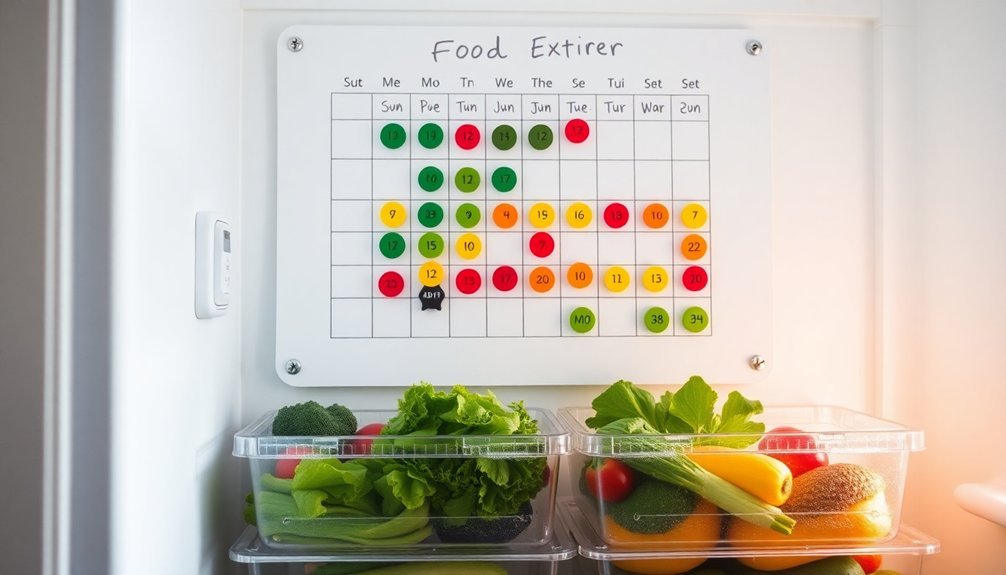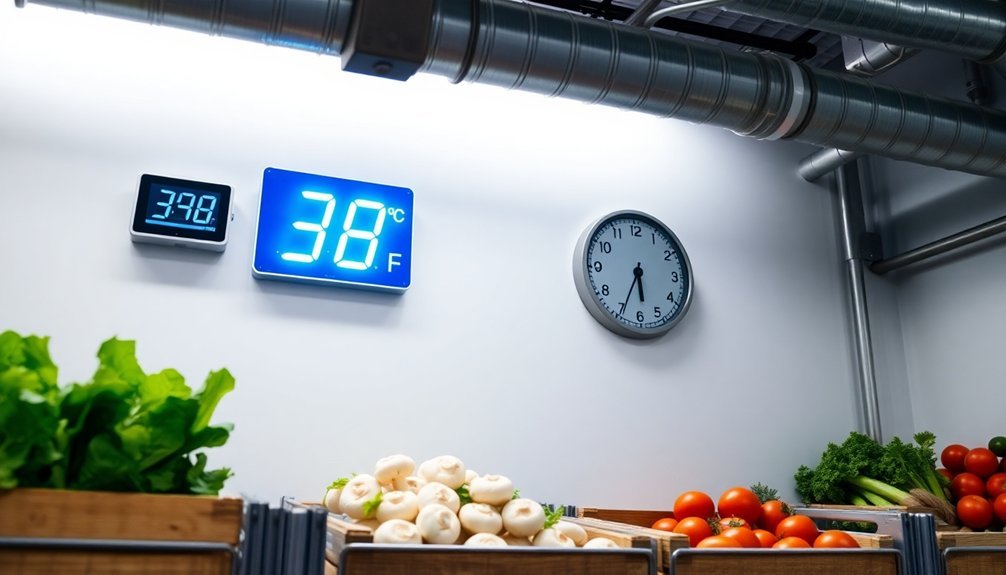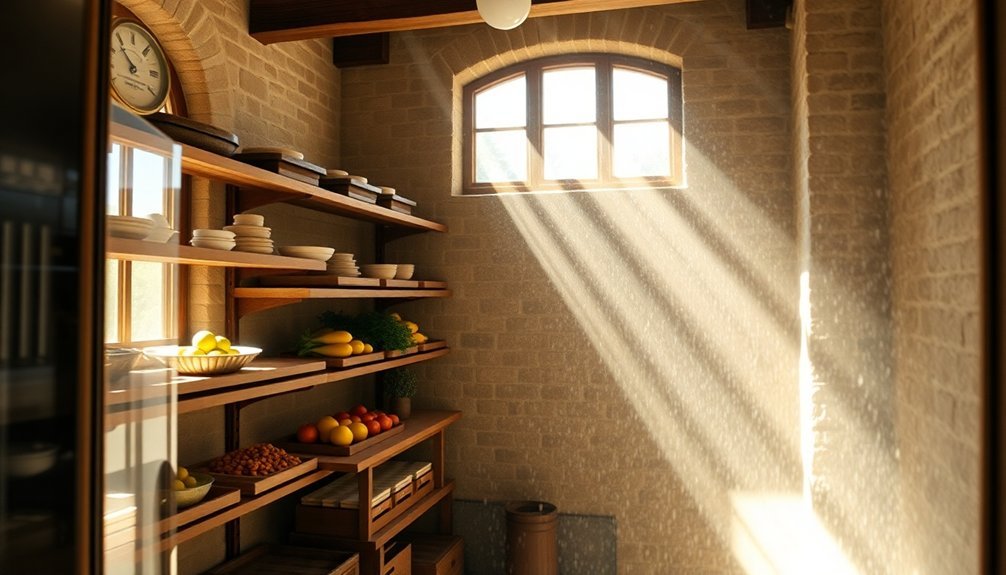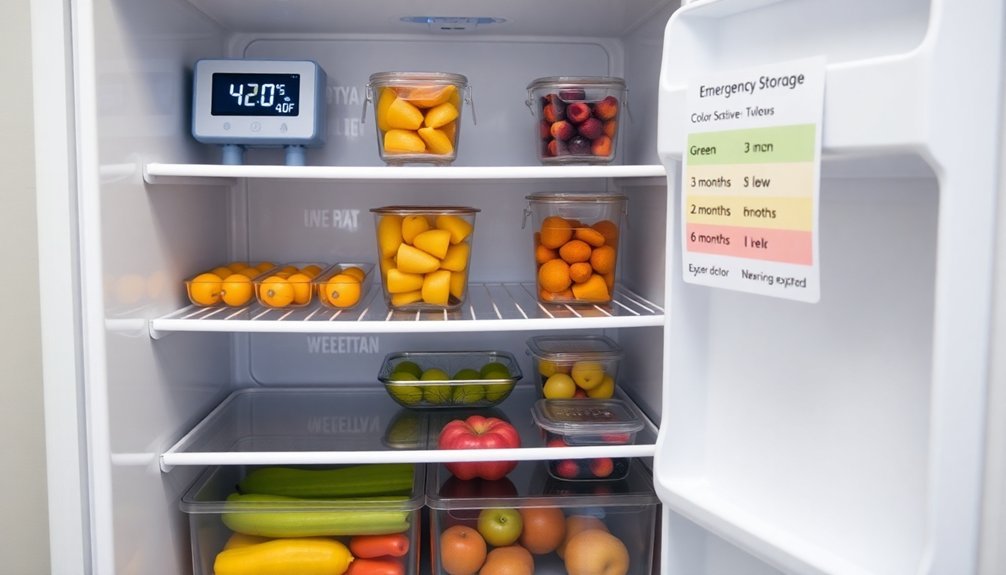You'll need a thorough daily and seasonal schedule to keep your spring house foods fresh. Start with daily temperature checks, keeping refrigerated items below 40°F and canned goods between 50-70°F. Clean spills immediately and inspect for signs of spoilage or pest activity. Perform weekly packaging checks and monthly seal integrity tests. Rotate your inventory using the FIFO method, and adjust ventilation seasonally to control humidity. During summer, monitor closely to maintain cool temperatures; in winter, prevent freezing with proper insulation. Following these time-tested protocols will reveal the full preservation potential of your spring house storage.
Understanding Spring House Storage Basics

The structure's design plays an essential role in food preservation by keeping out unwanted visitors.
You won't have to worry about fallen leaves, animals, or pests compromising your stored items.
Regular cleaning and maintenance are vital – you should inspect the spring house frequently to guarantee it's functioning properly and check stored foods for any signs of spoilage. Store items in clean, dark spaces to maintain optimal freshness.
Seasonal Temperature Impact Charts
Your spring house temperature control requires careful attention to each season's unique challenges.
During summer, you'll need to monitor temperatures closely to keep foods below 40°F, while winter demands protection against freezing with proper insulation and heat circulation.
Spring and fall shifts call for regular temperature checks and adjustments as outdoor conditions fluctuate between warm and cool days, ensuring your stored foods remain at ideal preservation temperatures. Seasonal preservation methods need adaptation throughout the year to maintain optimal food safety and prevent spoilage.
Summer Heat Storage Guidelines
Carefully monitoring seasonal temperature changes proves critical for preserving stored foods during summer months, when heat can greatly impact shelf life.
You'll need to keep your storage area below 85°F, with an ideal range between 50°F to 70°F, as every 18°F increase cuts your food's shelf life in half.
To protect your stored foods during summer heat, you'll want to avoid placing items near heat sources or in direct sunlight. Olive oil should be stored in a dark place and used within 3 months of opening.
Don't store food in your garage, where temperatures can easily exceed 90°F and greatly reduce shelf life. Instead, choose a cool, dry indoor location away from stoves and heating vents.
You should check your storage area's temperature regularly during hot spells. If you notice temperatures climbing above 85°F, you'll need to take action – either by improving ventilation, adding insulation, or relocating items to a cooler spot.
Keep canned goods off cement floors and away from damp surfaces to prevent rust.
Remember to store newer items behind older ones, and inspect your canned goods frequently for signs of heat damage, including bulging lids, leaks, or unusual odors.
Winter Freezing Protection Methods
During winter months, protecting stored foods from freezing temperatures requires strategic monitoring and prevention methods.
You'll need to maintain precise temperature control at 0°F (-18°C) or lower for items you want frozen, while protecting other foods from unwanted freezing.
For foods you're intentionally freezing, you'll want to use vacuum sealing or moisture-resistant packaging to prevent freezer burn.
Double-wrap items like prepared meals and confectionery products, and don't forget to label everything with dates.
Keep your freezer well-stocked but not overcrowded to maintain proper airflow and temperature stability.
When you're protecting non-frozen foods from winter's chill, you'll need to monitor storage areas carefully.
Install temperature alarms to alert you of any dangerous drops, and guarantee proper insulation around storage spaces.
If you must thaw anything, don't leave it at room temperature – use your refrigerator, cold running water, or microwave instead.
Spring-Fall Temperature Transitions
Seasonal temperature shifts create unique challenges for food storage throughout spring and fall changes. You'll need to monitor temperature fluctuations carefully, as spring temperatures typically rise by 0.5-1.5°F across most regions, with April being particularly dynamic for these changes.
You should keep your stored foods below 70°F, as temperatures exceeding 90°F can damage canned goods and accelerate food breakdown. During spring's warmer periods, you'll want to move food items to cooler, climate-controlled areas away from direct sunlight. This is especially important in the southeastern U.S., where both warming and precipitation increases are significant.
Monitor humidity levels closely, as spring's increased precipitation east of the Rocky Mountains can affect food quality. You'll need to check stored items regularly for signs of spoilage, including loose lids, bulging cans, or unusual odors.
Consider implementing preservation methods like canning or pickling to maintain food safety during these shifting periods. Track temperature patterns in your storage areas and adjust your storage locations accordingly.
You can use automation tools to help maintain consistent conditions and guarantee your food stays fresh throughout these seasonal changes.
Monthly Food Rotation Guide

Organization is key to maintaining a successful monthly food rotation system. You'll find that assigning specific meals to regular days of the week creates both variety and predictability in your spring house menu planning. By implementing a structured rotation, you're able to efficiently manage your food inventory while ensuring fresh, seasonal meals throughout the month.
| Weekday | Main Dish Ideas | Time-Saving Tips |
|---|---|---|
| Monday | Curry/Stir-Fry | Prep veggies Sunday |
| Wednesday | Soups/Pasta | Double batch for freezing |
| Friday | Fish/Slow Cooker | Set up night before |
Your rotation system should be flexible enough to accommodate seasonal changes while maintaining a consistent structure. Consider dedicating specific days to themes like Meatless Monday or Taco Tuesday, which helps streamline your grocery shopping and meal prep. You can experiment with new recipes on Sundays while keeping tried-and-true favorites in regular rotation during the week.
Don't forget to build in flexibility for using leftovers and accommodating unexpected schedule changes. By incorporating different variations of basic meals, you'll prevent menu fatigue while maintaining the efficiency of your food rotation system. Make sure to adjust portions and ingredients based on your family's preferences and seasonal availability.
Daily Storage Monitoring Steps
Vigilance in daily storage monitoring forms the backbone of an effective spring house food preservation system. You'll need to perform consistent checks throughout the day to maintain peak food safety and quality.
Start your day by inspecting all storage areas for cleanliness and organization. You should clean any food spills immediately to prevent bacterial growth and cross-contamination. Check that all storage containers are properly sealed and undamaged, replacing any that show signs of wear or damage.
You'll want to monitor for any signs of pest activity during your daily rounds. Look specifically for webbing, gnawed packaging, or droppings. If you spot any pest evidence, don't wait – contact professional pest control right away and document the incident.
Throughout the day, you must enforce the FIFO method, ensuring employees take products from the front of shelves rather than the back. Check that all items are properly dated and stored at appropriate heights to prevent cross-contamination.
You should also verify that your storage areas maintain proper temperature and humidity levels to protect food quality and safety.
Ideal Climate Control Settings

The natural cooling power of spring houses hinges on maintaining ideal climate conditions throughout the year. You'll find that the best temperature of around 50 degrees Fahrenheit comes from the underground spring water, which stays remarkably consistent regardless of external weather patterns.
When you're using a spring house, you don't need to adjust any settings – nature handles the climate control automatically through the continuous flow of cold spring water.
To maximize your spring house's cooling efficiency, you'll want to guarantee proper water circulation and maintain the structural integrity of the building. You can store food items by submerging them directly in the water channel, where they'll benefit from the constant cold temperature.
The enclosed design protects your stored items from outside heat while maintaining the cool ambient environment.
- Keep the water channel unobstructed to maintain steady flow and consistent cooling
- Position food containers in the deepest part of the water for maximum cooling effect
- Monitor the spring's output to guarantee it maintains its natural 50-degree temperature
- Seal any gaps in the structure to prevent warm air infiltration
- Arrange items to allow proper air circulation between stored containers
Long Term Preservation Methods
Successful long-term food preservation in your spring house depends on combining multiple proven methods to maximize shelf life.
You'll want to start with freezing for your most perishable items, using an air-blast or contact freezer after blanching vegetables to stop enzyme activity. Make sure you're using vacuum-sealed containers and labeling everything clearly.
For items that don't require freezing, you'll find dehydrating particularly effective. You can use a dehydrator to remove moisture from fruits and vegetables, storing them in airtight containers for up to a year.
Canning provides another reliable option, but you'll need to choose between water bath and pressure canning based on your foods' acidity levels. Remember to only use water bath canning when specifically indicated in tested recipes.
Don't overlook fermentation as a preservation method. You can create nutrient-rich preserved foods by submerging items in saltwater brine, producing favorites like sauerkraut and kimchi.
When you're implementing these methods, maintain proper storage conditions for each type. Keep your frozen goods at consistent temperatures, store dehydrated items in cool, dry spaces, and place fermented foods in dark areas.
Humidity Management Through Seasons

Managing humidity levels in your spring house requires careful attention as seasons change throughout the year. You'll need to adjust your ventilation and heating strategies based on outdoor conditions while maintaining proper air circulation to prevent moisture-related issues.
During warmer months, increase ventilation to reduce humidity, and monitor levels more frequently when humid weather sets in. In colder seasons, combine heating with controlled ventilation to manage moisture effectively.
To maintain ideal conditions, you'll want to inspect floors regularly for water pooling and confirm your drainage systems work properly. Don't let water puddle on surfaces, and keep plant spacing adequate to prevent moisture accumulation.
When cleaning, make sure surfaces dry thoroughly to avoid creating excess humidity.
- Check humidity levels daily during peak growing seasons
- Adjust ventilation settings weekly based on weather forecasts
- Clean and inspect drainage systems monthly
- Service HVAC systems quarterly for ideal performance
- Conduct thorough moisture audits at the start of each season
Remember to train your staff on proper moisture management protocols and implement preventive measures before humid seasons begin. Use desiccant dehumidification technology when necessary to maintain perfect conditions.
Weekly Maintenance Checklist
You'll need to carefully inspect all food packaging each week for tears, holes, or other damage that could compromise freshness.
Keep a daily log to track storage area temperatures, ensuring they stay within safe ranges for spring house food preservation.
Make it a habit to rotate your food inventory weekly, moving older items to the front and documenting dates to maintain ideal freshness throughout the season.
Check Packaging For Damage
Regular inspection of your food packaging serves as a critical defense against spoilage and contamination. You'll need to carefully examine all packaging materials weekly, checking for any signs of compromise that could affect food safety.
When conducting your inspection, pay close attention to seals, container integrity, and dimensional consistency to guarantee proper storage conditions.
Test the security of container seals by applying gentle pressure and checking for any loose spots or gaps. You should also measure packages to verify they maintain the correct dimensions for ideal product protection. Don't forget to document any issues you find during your inspection process.
- Look for obvious physical damage like tears, dents, or scratches that could compromise food safety
- Check seal integrity around edges, corners, and closure points
- Measure containers to guarantee they haven't warped or changed shape
- Verify that all packaging materials meet food-grade quality standards
- Test lid security and container construction under various handling conditions
Remember to use calibrated tools for accurate measurements and maintain detailed records of your inspections.
If you notice any deviations from standard specifications, address them immediately to prevent potential food safety issues.
Monitor Storage Area Temperature
A well-maintained temperature control system forms the foundation of food safety in your storage areas.
You'll need to monitor specific temperature ranges daily: keep your refrigerator at 40°F or lower and your freezer at 0°F or lower. For your canned goods, maintain temperatures between 50-70°F, while fruits and vegetables require ranges from 32-60°F, depending on the type.
Make temperature checks part of your daily routine for refrigerators and freezers. You'll want to document these readings to guarantee compliance and track any concerning patterns. Use reliable thermometers and conduct weekly inspections to catch any deviations from safe temperature ranges before they become problems.
Don't ignore your equipment maintenance – it's essential for consistent temperature control. Check seals, gaskets, and ventilation systems regularly.
When temperatures aren't properly maintained, you'll face serious consequences: foods can freeze unexpectedly at 32°F, canned goods deteriorate faster above 75°F, and improper temperatures lead to spoilage and food safety risks.
You'll also need to watch for temperature fluctuations that can diminish your food's nutritional value and quality. Clean your storage areas frequently to prevent debris and bacteria buildup that could affect temperature regulation.
Record Weekly Food Rotation
Maintaining a weekly food rotation checklist guarantees your spring house stays organized and food stays fresh. You'll want to establish a consistent rotation schedule that matches your meal planning and shopping routine. Record when you add new items and track their use-by dates to minimize waste.
Following a structured weekly meal rotation helps you manage inventory and certifies you're using ingredients at their peak freshness.
Implement your food rotation system by documenting these essential tasks:
- Check your pantry inventory every Sunday, noting which items need restocking and which are approaching their expiration dates.
- Record dates when you store prepped ingredients like chopped vegetables, cooked grains, and portioned proteins.
- Track your weekly meal rotation schedule (e.g., curry Mondays, pasta Tuesdays) to maintain variety and simplify planning.
- Monitor fresh produce usage and document when items need to be used immediately.
- Log temperature checks of storage areas to guarantee ideal conditions for food preservation.
Your weekly rotation records should align with your meal categories while maintaining flexibility for seasonal ingredients and special occasions.
This system helps you maximize ingredient usage and maintain a well-organized spring house throughout the week.
Emergency Storage Duration Guidelines

When planning your emergency food supply, understanding proper storage duration is essential for maintaining safe, edible provisions. You'll need to store your food in a cool, dry area with temperatures between 40° and 70°F to maximize shelf life. Keep all items elevated at least 2-3 feet off the floor and use waterproof, airtight containers for any foods that come in paper packaging.
| Food Type | Storage Duration | Special Notes |
|---|---|---|
| Canned Fruits/Vegetables | 24 months | Check for dents/swelling |
| Canned Fish | 18 months | Store in dark place |
| Canned Potatoes | 30 months | Maintain temp consistency |
| Dehydrated Potatoes | 30 months | Keep moisture-free |
| Dried Beans/Peas | 12 months | Use airtight containers |
You'll want to rotate your emergency food supply every 6-12 months, ensuring you're always stocked with fresh provisions. Don't forget to take into account special dietary needs and include ready-to-eat items that don't require cooking or water. If you notice any signs of contamination, such as swollen cans or exposure to flood water, discard the food immediately. Remember that maintaining proper storage conditions will greatly extend your food's shelf life.
Packaging Inspection Schedule
You'll need to perform visual checks of all food packaging at least once a month, looking for signs of damage, deterioration, or compromised seals.
Your inspection should include testing the integrity of tamper-evident seals by attempting to separate them without breaking the tamper indicator.
Make sure you're documenting each inspection, noting any issues found and corrective actions taken, to maintain compliance with food safety regulations.
Monthly Visual Checks
Regular visual inspections form the cornerstone of an effective packaging monitoring system.
You'll need to conduct thorough monthly visual checks of your facility's sanitary conditions and food storage procedures to maintain compliance with regulations. During these inspections, you should focus on examining the physical plant's condition, making sure all areas remain clean and dry, while monitoring refrigeration equipment performance and temperature readings.
To maximize the effectiveness of your monthly checks, you'll want to document all findings and maintain at least three months of inspection records. Remember that you can't submit documentation after an audit, so keeping real-time records is essential for compliance.
- Check storage areas for signs of pest infestation or evidence of spoilage
- Monitor air temperature readings in refrigerated spaces and verify equipment functionality
- Inspect raw material storage, production areas, and finished goods storage conditions
- Verify cleanliness of external areas and loading docks
- Document all findings immediately in your Food Safety File, including any corrective actions
If you discover any unsatisfactory conditions during your monthly checks, you'll need to address them promptly and schedule a follow-up inspection within 10 days to guarantee proper resolution.
Seal Integrity Tests
Beyond monthly visual checks, seal integrity testing provides a robust defense against product contamination.
You'll need to conduct these tests regularly to guarantee your Spring House food products maintain their freshness and safety. Start with visual inspections at 12-18 inches, using magnification devices to spot any gaps or misalignments in the seals.
For more thorough testing, you'll want to implement dye penetration tests, especially for packages where visual inspection isn't sufficient. This method will help you detect breaches that aren't visible to the naked eye.
You should also perform bubble leak tests by submerging packages underwater to check for any air escaping through compromised seals.
Don't forget to measure seal widths and evaluate peel characteristics as part of your testing protocol. These measurements must comply with EN 868-5 Annex E specifications to guarantee proper adhesion and long-term seal durability.
By combining these testing methods, you'll create a detailed seal integrity program that protects your products.
Remember that each test serves a specific purpose: visual checks catch obvious defects, dye tests reveal hidden breaches, and bubble tests confirm seal completeness.
Frequently Asked Questions
Can Spring House Foods Be Safely Repackaged Into Smaller Portions?
You can safely repackage spring house foods into smaller portions if you follow proper labeling requirements, use clean containers, maintain food safety standards, and include allergen information when needed on each package.
What Happens if Spring House Foods Accidentally Freeze During Transport?
If your Spring House foods accidentally freeze during transport, you'll notice quality changes and potential safety risks. You should check for thawing signs and use the items immediately or discard them to guarantee food safety.
Do Different Altitudes Affect the Storage Time of Spring House Products?
While altitude doesn't directly affect your Spring House products' storage time, you'll need to monitor humidity levels more carefully at higher elevations. The drier air at altitude can impact product freshness and moisture content.
How Do Power Outages Impact Spring House Foods in Climate-Controlled Storage?
During power outages, your spring house foods are at risk once temperatures deviate from 60-80°F. You'll have about 4 hours for refrigerated items and up to 48 hours for frozen foods if doors stay closed.
Can Vacuum Sealing Extend Spring House Shelf Life Beyond Manufacturer Recommendations?
Yes, you'll extend Spring House foods' shelf life 3-5 times longer with vacuum sealing. However, you should still monitor for quality changes and follow manufacturer's basic storage guidelines for best results.
In Summary
You'll maintain spring house food freshness by following a consistent daily and weekly schedule. Check temperatures twice daily, rotate perishables monthly, and inspect packaging weekly. Keep humidity between 80-95% in summer and 65-80% in winter. Monitor your climate control settings every 4-6 hours and respond immediately to any fluctuations. When properly managed, your spring house can preserve foods for 2-6 months depending on the item.





Leave a Reply